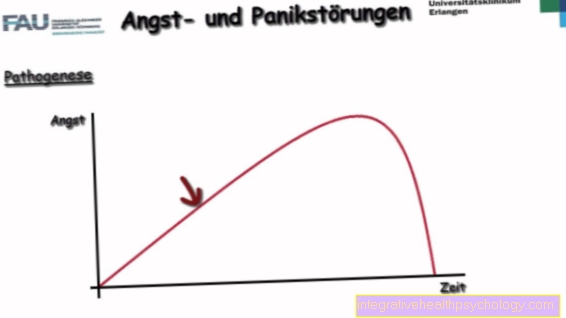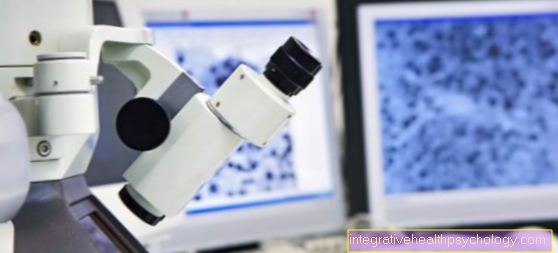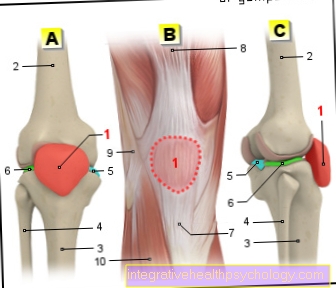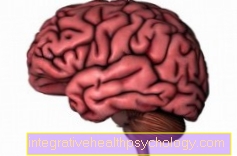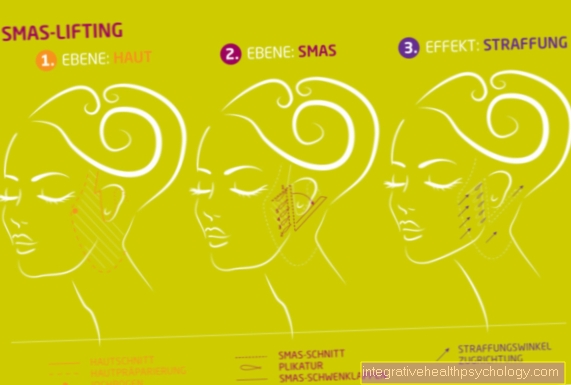blood cancer
Synonyms
leukemia, Hyperleukocytosis, leukosis
definition
Blood cancer is a disease of the hematopoietic and lymphatic system in which there is an excessive increase in white blood cells, the so-called Leukocytes, comes. Usually these are altered, non-functional white blood cells (Tumor cells). The precursors of the white blood cells in particular are found in greatly increased numbers in blood cancer.
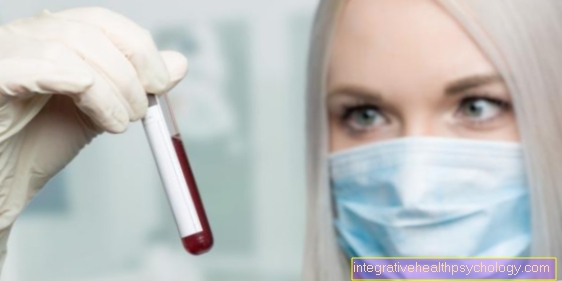
Due to the increased number of changed white blood cells, especially in the Bone marrow, there is a displacement of other blood cells, such as the red blood cells, of the Platelets and functional white blood cells. This leads to deficiency symptoms like one anemia (Anemia, lack of red blood cells), clotting disorders due to the lack of blood platelets or immune deficiencies due to the low number of functional white blood cells.
In addition, the white blood cells can infiltrate other organs in the body and thus impair their function, for example the liver, spleen or Lymph nodes.
Causes of Blood Cancer
A clear cause for the development of blood cancer is not yet known. However, there are some risk factors that can influence the development: radioactive radiation or X-rays, Chemicals such as pesticides or solvents (e.g. benzene), Drugs as part of tumor therapy (e.g. Cytostatics: Alkylating agents, Topoisomerase II Inhibitors or other drugs to suppress the Immune system), genetic predisposition e.g. in the form of Philadelphia chromosome (changed chromosome 22) and smoking.
Forms of blood cancer
Acute blood cancer: The acute form of blood cancer is a life-threatening disease that, if left untreated, can lead to death within a few weeks to months. Often the disease occurs out of complete health and very quickly develops into a serious clinical picture.
Chronic blood cancer: The chronic form of blood cancer usually begins insidiously and usually lasts for several years, with few to mild symptoms at the beginning. In this form, the number of pathologically increased white blood cells is not yet so increased that the other cells are too strongly displaced.
Symptoms
The first signs of a possible blood cancer are paleness, weakness, malaise, fatigue, fever, night sweats, weight loss, a tendency to bleed (frequent bleeding from the gums, prolonged menstrual bleeding, nosebleeds, spontaneous bruises, small hemorrhages on the skin (petechiae)). An increased susceptibility to infections, itching and swelling of the lymph nodes, liver or spleen are also signs of blood cancer.
There are no characteristic symptoms for the chronic or acute form of blood cancer. In most cases, however, the symptoms are less severe in the chronic form.
Read more on the topic:
- How do you recognize leukemia?
- Leukemia rash
How can you recognize blood cancer?
The different types of blood cancer can express themselves differently.
Straight in the acute forms there is often one rapid deterioration in general condition, to Signs of bleeding like nosebleeds, bleeding gums or bruises and too increased infections, which can sometimes be difficult. Also Lymph node swelling can indicate the presence of leukemia. One often falls in the blood count Increase in white blood cells on. One speaks here of a leukocytosis. There is often one at the same time Drop in platelets (Thrombocytopenia) and red blood cells (Anemia) that can be seen in the blood count. However, there are also forms of leukemia that can be expected to have a completely normal blood count.
The chronic forms of leukemia are not uncommon Incidental findingsbecause they hardly cause any discomfort and are then noticed during a routine examination. For example through abnormal blood tests or Swelling of the lymph nodes, spleen, or liver.
Classification and diagnostics
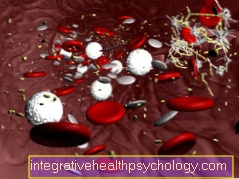
There are several subtypes of blood cancer, depending on which precursor cell the changed / degenerated blood cancer cells are derived from. One first distinguishes between myeloid of the lymphatic To form. The most important forms of blood cancer (leukemia) are listed below:
- acute myeloid leukemia (AML)
- acute lymphoblastic leukemia (ALL)
- chronic lymphocytic leukemia (CLL)
- chronic myeloid leukemia (CML)
The most important measure for diagnosing blood cancer is to examine the bone marrow and the peripheral blood. For this purpose, a blood count is made and the cell components of the blood examined under the microscope and the number of different cell types counted (number of red and white blood cells and number of blood platelets). Each form of blood cancer has a different but typical blood count.
Read more on the topic: Bone marrow puncture
With the help of imaging procedures such as ultrasound, MRI, CT or X-rays, it is possible to examine whether lymph nodes and other organs have already been infected with blood cancer.
Occurrence and frequency
The different types of blood cancer all have different age distributions and the probability of occurrence.
Acute lymphocytic leukemia (ALL): This form of blood cancer is rather rare, in Germany there are 1.5 new cases per 100,000 inhabitants every year. Acute lymphoblastic leukemia occurs mainly in childhood, 90% of all blood cancers in childhood are acute lymphoblastic leukemia, this form is rare in adults.
Acute myeloid leukemia (AML): The acute myeloid form of blood cancer occurs about twice as often as the acute lymphatic form (ALL). There are approx.2.5 new cases per 100,000 inhabitants. This form mainly affects adults, 80% of all leukemias in adulthood are acutely myeloid, with the age peak at 60 years.
Chronic myeloid leukemia (CML): The chronic myeloid form of blood cancer is also rather rare, with men being affected somewhat more often than women. Every year around 1-2 people per 100,000 population develop new CML.
Chronic lymphocytic leukemia (CLL): This type of blood cancer is the most common in the western hemisphere. The average age of onset is 60 years, only about 15% of the sick are younger than 55 years. Men get sick twice as often as women.
More information can be found here: Leukemia in children
Blood cancer in children
In children, leukemia is the most common cancer at around 30%. Acute lymphoblastic leukemia is by far the most common in childhood. This is a malignant disease of the blood-forming system.
The AML is acute. This means that if no therapy is initiated, the tumor cells spread rapidly in the bone marrow and thus displace the healthy cells from the bone marrow. Serious infections, bleeding and a significant reduction in the general condition, often with fever and swelling of the lymph nodes, occur.
If left untreated, the disease usually leads to death within a few months. While AML was almost a certain death sentence a few decades ago, the new forms of therapy today have a significantly better chance of recovery. About 80% of the sick children can be treated successfully.
Read more on the subject at: Leukemia in children
Is Blood Cancer Hereditary?
Leukemia diseases are not inherited in the strict sense of the word. However, there are still numerous things that have not been adequately researched.
There are Hereditary diseases that increase the risk of developing leukemia, for example that Down syndrom (Trisomy 21). Leukemia also seems to occur more frequently in families with an increased incidence of malignant diseases.
In conclusion, this question about the current state of science cannot be answered.
therapy
The choice of therapy depends on the type of blood cancer. The most common form of therapy is that Polychemotherapy. Several cytostatic drugs are administered to the patient. Cytostatics are cell toxins that curb the multiplication and growth of cancer cells. Cancer cells divide very often and are therefore particularly restricted by the drugs, but some healthy cells in the body also have a high division rate, which is then influenced by the drugs (e.g. mucous membrane cells). This is why chemotherapy can cause side effects in healthy organs of the body with temporary damage.
Side effects of chemotherapy:
- nausea
- Vomit
- general exhaustion
- Inflammation of the mucous membranes
- Hair loss
- Anemia
In addition to chemotherapy, a Bone marrow- or Stem cell transplant in combination to replace the diseased bone marrow with healthy ones. For this, a suitable bone marrow donor is required, similar to the blood transfusion.
Therapy options with have also found application in recent years monoclonal antibodies and Tyrosine Kinase Inhibitors (Imatinib and Dasatinib), which specifically intervene in the disease processes.
Therapy should only take place in specialized clinics or centers.
Further information on the topic can be found here: chemotherapy
Complications:
Blood cancer very much weakens that immune system, this can lead to complications in the course of the disease. Due to the weakened immune system, all leukemia patients (regardless of the type of leukemia) are very susceptible to infections. Also the risk of blood clots (Thrombosis) or bleeding increases as the blood cancer also affects the number of platelets, which are responsible for blood clotting. For these reasons, patients with blood cancer must be monitored closely and, if possible, not exposed to sources of infection.
More information can be found here: Chemotherapy side effects
Bone marrow donation and stem cell donation
There are two different types of donation that are used to help patients with leukemia. The bone marrow donation and the stem cell donation.
While the Bone marrow donation with a painful Bone marrow aspiration connected, it takes for one Stem cell donation just kind of long Taking blood after taking a drug. Nowadays, stem cell donation is almost the only thing that is used.
A stem cell transplant can be done from a donor to a patient. However, in some cases the patient himself may be the stem cell donor. One then speaks of an autologous stem cell transplant.
In the case of an external donation, the most important requirement is the so-called HLA compatibility. HLA molecules are specific tissue characteristics. The probability of a match of the HLA characteristics is highest in first-degree relatives. For many patients, however, there is no family member eligible for donation. Hence it has been around for several years Donor databases in which people who are ready to donate stem cells can be recorded. If you want to become a donor, you can get typed. This is done with a small blood sample or a swab taken from the lining of the cheek.
If a match (HLA-compatible donor) is found, the potential donor is examined in detail again before the donation. Among other things, to prevent diseases from being transmitted from the donor to the recipient.
Donors and recipients do not get to know each other. However, the donor can find out about the recipient's welfare a few weeks after the transplant. It is also possible to get to know each other personally if both parties wish.
forecast
The acute lymphatic form of blood cancer (ALL), which occurs most frequently in children, has a good chance of recovery. In about 80% of the cases the children are cured after the therapy.
In the acute myeloid form, the therapies used clear 50-90% of patients from cancer cells, but these can reappear. About 30-40% of all patients with AML are cured in the long term. Factors such as age, comorbidities and cytogenetic findings influence the prognosis for healing.
Aftercare:
Since the blood cancer cells can reappear even after successful therapy, long-term follow-up care for blood cancer patients is extremely important after treatment has been completed. Above all, this includes regularly examining the blood using a complete blood count and differential blood count. This type of follow-up can prevent the blood cancer (a so-called Relapse) with any consequential damage can be identified and treated at an early stage.
Is Blood Cancer Curable?
The term healing is not easy to use in medicine. This has to do with the fact that many diseases can be treated relatively well nowadays, but the disease can always relapse. It is the same with leukemia. In order to really cure leukemia, a stem cell transplant with prior combined chemotherapy and radiation therapy is usually requiredbecause this is the only way to kill all malignant cells. But even in patients who have received a stem cell donation, there are relapses (recurrences). The recurrence rate in leukemia after stem cell transplantation is assumed to be around 20%.
prophylaxis
Since no clear cause of blood cancer is known, there are no clear measures that could prevent the development of blood cancer. However, by avoiding certain factors, one can keep the risk of such a disease lower. This includes, for example:
Careful handling of chemical pollutants, such as benzene or other substances containing benzene.
Ionizing radiation, e.g. X-rays, should be well dosed. This means unnecessary X-ray examinations should be avoided, the best thing is to have an X-ray passport issued by the treating radiologist in which all X-ray examinations are recorded in order to keep a good overview of the examinations that have been carried out.
If treatment is already taking place within the framework of tumor therapy, close attention should be paid to possible changes and symptoms in the context of the blood cancer.
In general, states of malaise with weakness, tiredness, night sweats, weight loss and other possible symptoms should be clarified with the doctor at an early stage, because the earlier a disease of the blood-forming system is recognized, the better the chances of a permanent cure.
All in all, blood cancer is a relatively rare cancer compared to other cancers like Chest- or Prostate cancer. Another positive aspect is that thanks to modern therapy methods, blood cancer can be cured in many cases.
Summary Acute Myeloid Leukemia (AML)
Acute myeloid leukemia, or AML for short, is a malignant (malignant) disease of the blood-forming system. It is one of the blood cancer diseases. AML is a rare disease. Almost 4 in 100,000 people fall ill every year. she comes more common in old age before, the mean age of onset is between 60 and 70 years.
The disease can get through earlier general unspecific symptoms how fatigue and chronic fatigue show. Since the disease, as the name suggests, is relatively acute, the symptoms multiply within a short time and increase significantly. Possible symptoms are one pale skin color because of a Anemia, Signs of bleeding like Zpork or nosebleeds, increased bruising or occurrence of small bleeding in the area of the lower legs. These show up as small red spots which appear in groups, they are called petechiae. There is also often one increased susceptibility to infection. Patients are increasingly suffering from diseases such as pneumonia or tonsillitis. It can continue to profuse night sweats come. Also one Thickening of the gums (Gingival hyperplasia) can be a possible symptom.
When making a diagnosis, the anamnesis takes place first. The most important thing here is which symptoms have existed and since when. The physical exam may show signs of bleeding such as petechiae or bruises, and pale skin may be noticed. The next step is to take blood. The so-called Differential blood count When viewed together with the symptoms, it often provides important information about the possible presence of AML. To confirm the diagnosis, the Bone marrow puncture respectively; the puncture is then examined microscopically and the diagnosis is made.
Appropriate therapy should be initiated quickly after the diagnosis has been made. Above all, here is the chemotherapy with a combination of several drugs in the foreground. In the first phase of chemotherapy, patients are highly susceptible to life-threatening infections due to a severe weakening of the immune system and must therefore be isolated in most cases. Another option for treatment is that Stem cell transplant. The prognosis depends, among other things, on the age and the subspecies of AML. Some patients can be considered cured by treatment. However, it is not uncommon for others to relapse (relapse).
Summary Chronic Lymphocytic Leukemia (CLL)
Chronic lymphocytic leukemia, or CLL for short, is one of the Non-Hodgkin lymphoma and is in our latitudes the most common form of leukemia. It occurs especially at an advanced age and has the best prognosis of all forms of leukemia. In contrast to the acute forms of leukemia, it is chronic, which means that it can drag on for many years without the patient's general condition deteriorating. About 4 in 100,000 people fall ill every year. The mean age at initial diagnosis is between 70 and 75 years.
The malignant leukemia cells multiply in the bone marrow and spread there. As a result, they often displace the cells that actually belong there, namely the blood-forming cells. This can mean that these blood-forming cells have to move to other organs in order to produce the blood components. The liver and spleen are particularly affected. The liver (hepatomegaly) and spleen (splenomegaly) may then swell. This is usually not noticed by the patient but only becomes apparent during a physical examination or an ultrasound examination. In addition, CLL often causes swelling of the lymph nodes in various parts of the body. Furthermore, symptoms can appear on the skin, for example with itching or eczema.
CLL is not infrequently an incidental finding. The diagnosis is made based on the medical history and blood count with extended examinations. In rare cases, bone marrow aspiration is also necessary. As a rule, however, it is not absolutely necessary to establish a diagnosis.
The disease is divided into different stages. In stages A and B, the disease is only treated if it causes symptoms. This is because it often progresses for years without getting worse. In advanced stage C or if symptoms occur, chemotherapy or antibody therapy can be initiated. A stem cell transplant is also an option for selected patients. CLL is the least aggressive form of leukemia.
Summary of acute lymphoblastic leukemia (ALL)
Acute Imypatic Leukemia, or ALL for short, is an acute form of blood cancer that is characterized by an infestation of the bone marrow with malignant cells. About 1.5 out of 100,000 people fall ill every year, making ALL a rare disease. The ALL is nonetheless that most common malignant disease in childhood. In children under 4 years of age, the incidence rate is around 6.5 per 100,000 children per year.
The symptoms arise mainly from the fact that the healthy cells of the bone marrow are displaced by the malignant cells and can therefore no longer adequately fulfill their task. Of the Lack of healthy white blood cells leads to a significantly increased susceptibility to infection. Those affected are significantly more likely to develop diseases such as pneumonia and the courses are sometimes life-threatening.
Of the Deficiency of red blood cells leads to a Anemia with pale skin, decreased performance and general weakness. A Lack of platelets leads to Signs of bleeding, such as the significantly increased occurrence of bruises, gum or nosebleeds and the occurrence of small punctiform hemorrhages (petechiae), especially in the area of the lower legs. By displacing the blood-forming cells from the bone marrow, these cells have to do their work elsewhere. They move to the spleen and liver, so there is often a noticeable ALL in ALL Enlargement of the liver and spleen (Hepatosplenomegaly). Also fever occurs frequently, as does one Swelling of the lymph nodes. Especially in children, the first symptom of ALL Bone pain occur.
The anamnesis is groundbreaking for the diagnosis. A blood test will also be done. However, this does not always have to produce the typical finding with a significantly increased number of white blood cells, so that a bone marrow examination is necessary to confirm the diagnosis. The material obtained is then examined under a microscope and the diagnosis made. There are further special examinations such as immunophenotyping, if necessary an imaging of the head and a nerve water puncture.
Therapy then usually takes place with chemotherapeutic agents, and cortisone preparations are also often used. In recent years, the prognosis of patients with ALL has improved significantly, but it is still a highly malignant disease that is not infrequently fatal.
Summary Chronic Myeloid Leukemia (CML)
Chronic myeloid leukemia, or CML for short, is primarily an adult disease. Like the other forms of leukemia, it is a rare disease with an annual occurrence in almost 2 in 100,000 people. It accounts for about 20% of leukemias.
In most cases, the cause of the disease is a genetic change in two chromosomes that swap some of their genes. One speaks of a Philadelphia chromosome. The change leads to a permanent activation of a certain enzyme and thus to unhindered growth of the affected cells. Despite the fact that it is a genetic mutation, the disease is not hereditary in the conventional sense, as the mutation only occurs in the course of life.
There are three stages in CML: the chronic phase in which the person affected can remain with few symptoms for years, the acceleration phase and the blast crisis, which proceeds like acute leukemia and, if left untreated, leads to death.
The symptoms are rather minor. Often the chronic stage CML is noticed during a routine examination. For example, because of a significantly increased number of white blood cells in the blood or because of an enlarged spleen. In the acceleration phase, symptoms typical for leukemia such as fatigue, paleness and a tendency to bleed increase.
In addition to the medical history and physical examination, a blood sample and a bone marrow examination are diagnostic options. Therapeutically, the cytostatic hydroxycarbamide and above all a drug from the group of tyrosine kinase inhibitors can be used. Antibody therapy can also be used. A stem cell transplant may be considered for full healing. However, a stem cell transplant is no guarantee of a cure.
Also read the article: The tyrosine kinase.


